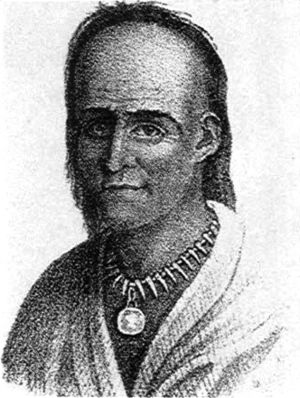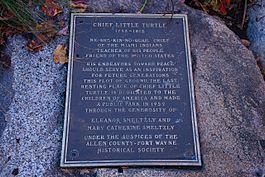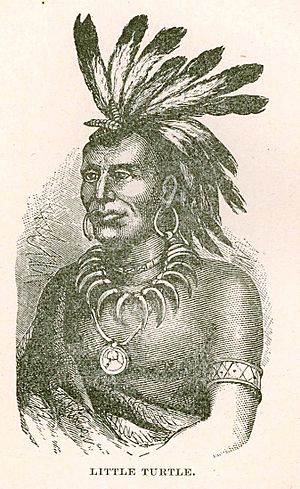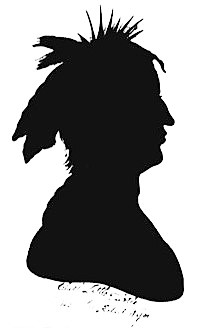Little Turtle facts for kids
Quick facts for kids
Little Turtle
Mihšihkinaahkwa |
|
|---|---|

Lithograph of Little Turtle, reputedly based upon a lost portrait by Gilbert Stuart that was destroyed when the British burned Washington, D.C., in 1814.
|
|
| War chief of the Miami people | |
| Personal details | |
| Born | 1747/1752 Miami territory, Illinois Country (modern Whitley County, Indiana, United States) |
| Died | July 14, 1812 Fort Wayne, Indiana, United States |
| Military service | |
| Allegiance | Miami people |
| Battles/wars | Northwest Indian Wars |
Little Turtle (Miami-Illinois: Mihšihkinaahkwa) (around 1747 – July 14, 1812) was a powerful chief of the Miami people. He became one of the most famous Native American military leaders. In the 1790s, Little Turtle led a group of Native American warriors to big wins against U.S. forces. This conflict was called the Northwest Indian Wars, or sometimes "Little Turtle's War."
One of his biggest victories was St. Clair's defeat in 1791. In this battle, his forces defeated General Arthur St. Clair. The U.S. Army lost many soldiers, making it their biggest loss against Native American forces. Later in his life, Little Turtle signed treaties that gave away land. This caused him to lose some of his leadership status before the War of 1812.
Contents
What's in a Name?
Little Turtle is the English way of saying mihšihkinaahkwa. This is how his name sounds in the Miami-Illinois language. His native name has been written in many different ways over time. These include Michikinikwa, Meshekunnoghquoh, and Michikinakoua. The name comes from a type of turtle, probably the Midland painted turtle.
Early Life and Appearance
We don't have many records about Little Turtle's early life. We are not sure exactly when or where he was born. Most sources say he was born in 1747 or 1752. His parents lived in a Miami village called Pickawillany around that time.
Little Turtle was born in what is now Whitley County, Indiana. This was either in a small Miami village by Devil's Lake or a larger village called Turtletown. He lived at Turtletown, near the Eel River, until 1780.
People described Little Turtle as being almost six feet tall. He was a serious man and did not like people drinking too much. He enjoyed wearing silver decorations on his ears and clothes.
His Military Career
Becoming a War Chief
Little Turtle became the war chief for a part of the Miami people. He earned this role by showing great skill and bravery in battles. Even though he was a war chief, he was never the main chief of the Miami tribe. That position was passed down through families.
La Balme's Defeat
Little Turtle first became famous during the American Revolutionary War. He fought against a French force that was helping the Americans. This force was led by a French adventurer named Augustin de La Balme. In October 1780, La Balme's group attacked and took goods from Miamitown. This was part of his plan to attack the British in Detroit.
La Balme stopped to camp near the Eel River. This was just three miles south of Little Turtle's village. Little Turtle got permission to lead an attack. On November 5, 1780, Little Turtle attacked La Balme's camp. He killed La Balme and forty of his men. The rest were taken prisoner. Little Turtle's army had almost no losses. This victory ended La Balme's mission. It also made Little Turtle known as a strong war leader.
Through the 1780s, Little Turtle kept leading raids against American settlements in Kentucky. He fought alongside the British. However, not all Miami groups supported the British. Some, like the Piankashaw Miami, helped the Americans. Others, like the Wea Miami, sometimes helped the British and sometimes the Americans.
Little Turtle's War
After the American Revolutionary War ended in 1783, the British gave up land between the Appalachian Mountains and the Mississippi River to the U.S. government. Native Americans living there did not want American settlers to move onto their lands. This led to more fighting.
Native tribes formed the Northwestern Confederacy. Their goal was to keep the Ohio River as a border between their lands and the United States. Little Turtle became a key war leader of this group. Other leaders included Blue Jacket of the Shawnee and Buckongahelas of the Delaware. The war that followed was called the Northwest Indian War, or "Little Turtle's War."
Little Turtle helped lead Native Americans against U.S. forces in late 1790. The U.S. government sent troops under General Josiah Harmar. But Harmar's soldiers were not well-trained or supplied. In October 1790, Little Turtle and Blue Jacket won two battles against Harmar's men. These wins made other tribes want to join the fight.
In August 1791, Little Turtle's daughter was captured during a raid on a Miami village. By September 1791, a large American army of 1,400 to 2,000 soldiers was moving north. They were led by Arthur St. Clair.
The Battle of St. Clair's Defeat
Little Turtle is often given credit for leading about 1,000 warriors in a huge victory. They defeated the U.S. forces near the Wabash River on November 4, 1791. This battle is still the U.S. Army's worst defeat by Native Americans. The U.S. lost 623 soldiers and 258 were hurt. The Native American forces lost about 100 men. Both Little Turtle and Blue Jacket said they were in charge of the Native American forces. This caused some disagreements within the Confederacy.
In November 1792, Little Turtle led 200 Miami and Shawnee warriors. They attacked a convoy of horses and Kentucky militia near Fort St. Clair. Little Turtle's warriors attacked at dawn. The militia ran into the fort. Little Turtle's force lost two warriors but captured the camp and its supplies. Most of the horses were lost.
Between 1792 and 1794, General Anthony Wayne led a new U.S. army. Wayne trained his 3,500 troops very carefully. In June 1794, Wayne's forces fought off an attack on Fort Recovery. About 1,000 warriors attacked the fort. After this, Little Turtle advised his people to make peace. He said that Wayne was "the chief that never sleeps."
Little Turtle could not convince the other tribal leaders to make peace. So, he stepped down as the main war chief. He is said to have given command to Blue Jacket. However, Little Turtle still led his own group of Miami tribesmen. Little Turtle's son-in-law, William Wells, also saw that the Native American alliance might lose. He decided to help the Americans. Wells worked as a scout for General Wayne.
Battle of Fallen Timbers
The Native American confederacy, with about 1,000 warriors, was defeated at the Battle of Fallen Timbers in August 1794. This battle happened near the Maumee River. After the battle, the Miamis left their village of Kekionga. They moved to other villages along the Eel, Mississinewa, and Wabash Rivers.
After this defeat, the Native American leaders signed the Treaty of Greenville in 1795. This was a big change in their fight against American expansion. Little Turtle traveled to Greenville and spoke before signing the treaty. He told his people to "adopt American ways." He hoped the treaty would make relations better between Americans and Native Americans. His wife died the next day at the camp.
Even though the treaty was signed, some Native American raids continued until 1815. For the rest of his life, Little Turtle worked for peace. Some people saw him as someone who believed his people had to change to survive.
Later Years and Efforts for His People
After the Battle of Fallen Timbers in 1794 and signing the Treaty of Greenville in 1795, Little Turtle did not join the Shawnee chief Tecumseh. Little Turtle kept working for peace and cooperation. He also started to adopt some American customs, like owning his own land. He strongly believed that his people should not use harmful substances.
Little Turtle traveled east many times to meet with three U.S. presidents. He met President George Washington in November 1796. Washington gave him a special sword. He also met General Tadeusz Kościuszko, who gave him two pistols. In 1797–98, Little Turtle met with President John Adams.
President Thomas Jefferson also talked with Little Turtle. Jefferson wanted to encourage American farming methods among the Miami people. Little Turtle also visited Washington, D.C., in 1801–02 and 1809–09 to meet with President Jefferson. Little Turtle and other chiefs asked Jefferson for farming tools and animals. Jefferson provided them to help the tribes learn farming.
Little Turtle strongly believed that his people should avoid harmful substances. On January 14, 1802, he spoke to President Jefferson and members of the U.S. Senate. He asked them to stop people from selling harmful substances to his people. He explained that these substances caused many problems for his community. Jefferson and Congress were impressed. On March 30, 1802, Congress passed a law to restrict the sale of these substances to Native Americans.
In 1809, Little Turtle had a disagreement with other Miami leaders. William Henry Harrison, the governor of the Indiana Territory, came to Fort Wayne to make new treaties. Harrison worked with Little Turtle and his son-in-law, William Wells. They helped Harrison get the Treaty of Fort Wayne (1809). This treaty gave the U.S. government 2.5 million acres of land.
Other tribal leaders, like Pacanne, did not want to give up more land. Harrison had to recognize other chiefs as the true leaders of the Miamis, not Little Turtle. Little Turtle signed the treaty, but after that, he was "forcibly retired from Miami affairs." Shawnee chief Tecumseh and his brother, Tenskwatawa, spoke out against the treaty. They began talking with the British about forming an alliance.
Little Turtle moved to a Miami village northeast of Fort Wayne, Indiana. During the War of 1812, General Harrison ordered the destruction of Miami villages near Fort Wayne. Harrison's forces destroyed the village where Little Turtle lived. However, they did not destroy Little Turtle's own home, which the U.S. government had built for him.
Death and Lasting Impact
Little Turtle died on July 14, 1812, at the home of his son-in-law William Wells. He had been sick for some time. He was given a military funeral with full honors at Fort Wayne. Little Turtle was buried in his family's burial ground. Wells died one month later in the Battle of Fort Dearborn.
In 1912, Little Turtle's grave was accidentally found by workers. His remains were moved. The items buried with him, like the sword from President Washington and the pistols from Kosciusko, were later put on display. They are now in the collection of the Allen County-Fort Wayne Historical Society.
Little Turtle is remembered for first fighting to protect his people. Later, he worked with others to ensure their survival.
Places Honoring Little Turtle
| Little Turtle Memorial | |
|---|---|
 |
|
| Type | Municipal Park and Gravesite |
| Location | 634 Lawton Place, Fort Wayne, Indiana |
| Area | 0.13 acres (0.05 ha) |
| Created | 1960 |
| Operated by | Fort Wayne Parks and Recreation |
His Burial Site
In 1959, two sisters, Mary Catherine Smeltzly and Eleanor Smeltzly, bought Little Turtle's burial site. They wanted to honor his efforts for peace. They gave the land to the city as a public park. A bronze plaque on a granite rock was put up in 1960. In 1994, the memorial was improved.
A small stone at Little Turtle's grave reads:
CHIEF LITTLE TURTLE
1752-1812
ME-SHE-KI-NO-QUAH
CHIEF OF THE MIAMI INDIANS
TEACHER OF HIS PEOPLE
FRIEND OF THE UNITED STATES
HIS ENDEAVORS TOWARD PEACE
SHOULD SERVE AS AN INSPIRATION
FOR FUTURE GENERATIONS
THIS PLOT OF GROUND, THE LAST
RESTING PLACE OF CHIEF LITTLE TURTLE
IS DEDICATED TO THE CHILDREN OF AMERICA AND MADE
A PUBLIC PARK IN 1959
THROUGH THE GENEROSITY OF
ELEANOR SMELTZLY AND
MARY CATHERINE SMELTZLY
UNDER THE AUSPICES OF THE
ALLEN COUNTY-FORT WAYNE
HISTORICAL SOCIETY
Places in Indiana Named for Little Turtle
- Camp Chief Little Turtle (a Boy Scout camp near Angola)
- Little Turtle Elementary School, Columbia City, Indiana.
- Little Turtle Branch of the Allen County Public Library
Places in Ohio Named for Little Turtle
- A neighborhood with a golf course in Columbus.
- A street named "Little Turtle Court" in Ross, Ross Township.
- Little Turtle, Ohio, a town founded in 1968.
- Turtle Creek in Turtlecreek Township, Warren County.
Other Places
- Lake Erie's Turtle Island, on the border of Michigan and Ohio.
- Defiance College in Defiance, OH honors Chief Little Turtle with a statue outside the Pilgrim Library.
See also
 In Spanish: Michikinikwa para niños
In Spanish: Michikinikwa para niños




